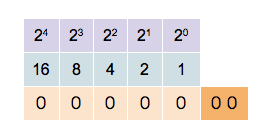Binary number
Binary number is a number represented in the base-2 numeral system which uses only two symbols: typically "0" (zero) and "1" (one). The binary system is utilized internally by almost all modern computers and computer-based devices because it is straightforward to implement with digital electronic circuitry.
History[edit | edit source]
The concept of binary numbers dates back to ancient times, but the modern binary number system was fully developed in the 17th century by Gottfried Wilhelm Leibniz, a German mathematician and philosopher. Leibniz was inspired by the ancient Chinese I Ching or Book of Changes, which used a system of binary codes to represent philosophical concepts.
Usage[edit | edit source]
Binary numbers are used extensively in the field of computer science. Computers use binary to process data and perform operations. This is because digital electronics, which power computers, recognize two states: on and off, which correspond to 1 and 0, respectively. Thus, binary numbers simplify the design of computers and other digital devices.
Representation[edit | edit source]
In the binary system, each digit in a binary number is referred to as a bit. A bit is the smallest unit of data in computing and can represent two distinct states. Multiple bits can be combined to form more complex data structures. For example, a byte, which consists of 8 bits, can represent 256 different values (2^8).
Conversion[edit | edit source]
Binary numbers can be converted to and from other number systems, such as the decimal number system (base-10) and the hexadecimal number system (base-16), which are more familiar to humans. Conversion between these systems is a common task in computer science and digital electronics.
Operations[edit | edit source]
Basic arithmetic operations, such as addition, subtraction, multiplication, and division, can be performed on binary numbers. These operations follow rules similar to those in the decimal system but are generally simpler because they involve only two symbols.
Applications[edit | edit source]
Beyond their fundamental role in computing, binary numbers are also used in various coding schemes, including binary-coded decimal (BCD) and Gray code, and in error detection and correction algorithms.
See Also[edit | edit source]
- Need help finding a doctor or specialist anywhere in the world? WikiMD's DocFinder can help with millions of doctors!
| This article is a stub. Help WikiMD grow by registering to expand it. |
Navigation: Wellness - Encyclopedia - Health topics - Disease Index - Drugs - World Directory - Gray's Anatomy - Keto diet - Recipes
Search WikiMD
Ad.Tired of being Overweight? Try W8MD's physician weight loss program.
Semaglutide (Ozempic / Wegovy and Tirzepatide (Mounjaro) available.
Advertise on WikiMD
WikiMD is not a substitute for professional medical advice. See full disclaimer.
Credits:Most images are courtesy of Wikimedia commons, and templates Wikipedia, licensed under CC BY SA or similar.Contributors: Prab R. Tumpati, MD






